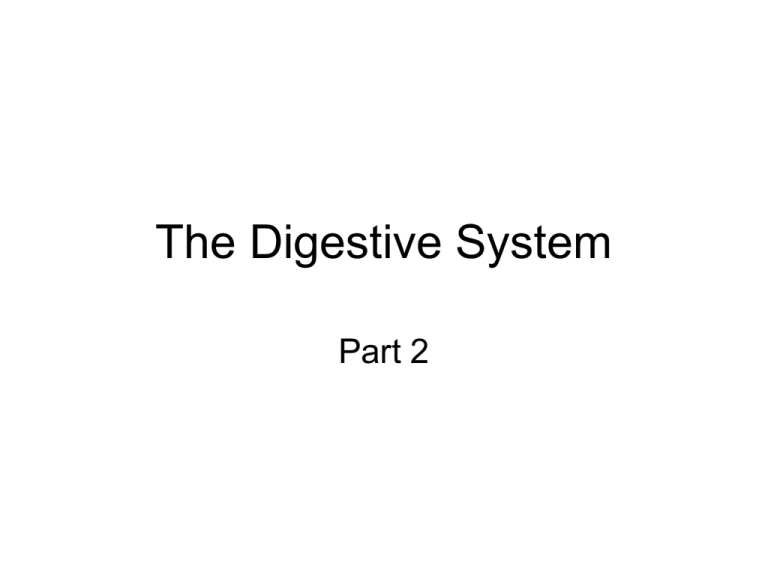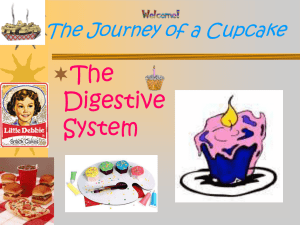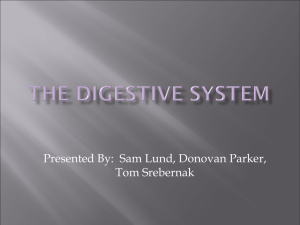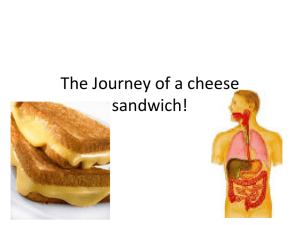
The Digestive System
Part 2
What has happened to the food so
far?
• Food has been ingested
• Mechanical digestion has occurred in the mouth
increasing the surface area and forming a food
bolus
• Salivary amylase has been secreted in the saliva
and carbohydrates have been broken down into
smaller chains
• Lingual lipase has been added to the food bolus
• Peristaltic motion of the esophagus has moved
the bolus to the cardiac sphincter of the stomach
The Stomach
• Mechanically breaks up food particles
• Liquefies the food
• Begins the chemical digestion of proteins
and a small amount of fat
• Produces CHYME—pasty mixture of
semidigested food that is passed into the
small intestine
Four Regions of the Stomach
• Cardiac Region—anterior section (nearest
the heart); receives food from esophagus
• Fundic Region—Dome shape portion
superior to the esophageal attachment
• Body Region—Greatest part of the
stomach
• Pyloric Region—posterior section; where
food moves into the small intestine
The Wall of the Stomach
• Has a layer of mucosa on the inside of the
stomach
• The gastric mucosa contains depressions
called gastric pits
• Cells in bottom of pits replace epithelial
cells that are sloughed off into chyme
• Gastric pits also contain glands that are
made of various cell types
The Role of Hydrochloric Acid in
the Stomach
Gastric juice has high concentration of HCl and
can have a pH as low as 0.8
Functions of acidic environment:
1. Activates enzymes pepsin and lingual lipase
2. Breaks up connective tissues & plant cells
walls, helps to liquefy food & form chyme
3. Converts ingested ferric ions (Fe3+) to ferrous
ions (Fe2+) to be used in hemoglobin
production
Types of Cells found in Gastric Pits
• Mucous Cells—predominate cardiac & pyloric
glands; secrete mucous
• Regenerative (stem) Cells—produce a continual
supply of new cells to replaced sloughed off cells
• Parietal Cells—secrete HCl & intrinsic factor;
found mostly in gastric glands
• Chief Cells—Most numerous cell type, secrete
chymosin & lipase in infancy and pepsinogen
throughout life
• Enteroendocrine Cells—Secrete hormones &
other messengers that regulate digestion
Digestive Enzymes in the Stomach
• Pepsinogen is converted to PEPSIN, an
enzyme that breaks down proteins to small
amino acid chains
• In infancy, gastric lipase digests the
butterfat of milk
• In infancy, chymosin (renin) curdles milk
• Intrinsic Factor—Essential for absorption
of vitamin B12 in the small intestine
Gastric Motility
• The medulla swallowing center signals the stomach to
relax when we swallow; this prepares the stomach to
receive food
• Arriving food stretches the stomach
• The stomach begins peristaltic contractions governed by
pacemaker cells in the stomach wall
• Contractions occur every 20 seconds and get stronger
as they move throughout the stomach
• After 30 minutes the contractions are strong
• About 3 mL of chyme at a time is squirted into the small
intestine
• Typical meal is emptied from the stomach in 4 hours
Why does the stomach not digest
itself?
• It has a mucous coat that is highly alkaline
(basic)
• Epithelial cells live only 3 to 6 days and
then are sloughed off into the chyme and
replaced
• Epithelial cells are joined by tight junctions
that prevent gastric juice from seeping
between them
Accessory Organs
Liver—Secretes bile into small intestine; home to
the gall bladder; after a meal the liver removes
glucose, amino acids, vitamins, and other
nutrients for its (liver’s) metabolism & storage
Gall Bladder—Sac on the underside of the liver
that stores & concentrates bile
Bile—Yellow-green fluid containing minerals,
cholesterol, fats, phospholipids, bile pigments &
bile acids; principal pigment is bilirubin derived
from the breakdown of hemoglobin; bile acids
aid in fat digestion & absorption
Accessory Organs
• Pancreas—both an endocrine (insulin &
glucagon) and exocrine organ; secretes
about 1,200 to 1,500 mL of pancreatic
juice per day; pancreatic juice is alkaline
(basic) and buffers chyme from stomach in
the small intestine; pancreatic enzymes
include trypsinogen, chymotrypsinogen,
and procarboxypeptidase; pancreatic
amylase, pancreatic lipase, ribonuclease,
and deoxyribonuclease
What has happened to the food so
far?
• The bolus from the esophagus has moved into the
cardiac sphincter of the stomach
• The stomach mechanically digests the food
• The churning mixes the food with pepsin that
breaks down protein into smaller amino acid chains
• And, lingual lipase is activated beginning to break
down lipid (fat) molecules
• The food material becomes a pasty substance
called CHYME
• The chyme is released into the small intestine
through the pyloric sphincter about 3 mL at a time.
The Small Intestine
• The site of nearly all of the chemical digestion
• The site of nearly all nutrient absorption into the
bloodstream
• Has a large surface area exposed to chyme
because of the presence of villi and microvilli—
folds of the mucous membranes of the small
intestine
• 6 to 7 m (18 – 22 ft) in cadaver; 2 m long (6.5 ft)
in living person because of muscle tone
• Named “small” intestine because diameter is
smaller than the “large” intestine
Three Regions of the Small
Intestine
• Duodenum—First 25 cm beginning at the
pyloric valve; receives chyme from
stomach and the pancreatic juice & bile;
stomach acid is neutralized here; fats are
broken up by bile acids, pepsin is
inactivated by high pH, and pancreatic
enzymes take over chemical digestion
• Jejunum—Next 2.5 m
• Ileium—Last 3.6 m
Specialized Structures of the Small
Intestine
Villi—Fingerlike projections of the mucosa
that increase SA
• Covered with absorptive cells (to move
nutrients to blood stream)
• Core contains an arteriole, a capillary
network (for nutrient absorption), a venule,
and a lymphatic capillary called a lacteal
(absorbs fat)
Specialized Structures of the Small
Intestine
• Microvilli—Tiny projections from each villus;
called a brush border; further increases SA;
contains brush border enzymes; chyme must
come in contact with these enzymes for
digestion to occur
• Intestinal Crypts—Similar to gastric pits;
dividing stem cells replacing mucosal cells every
3 to 6 days
• Paneth Cells—Secrete lysozyme, & other
chemicals protecting against bacterial infection
• Duodenal Glands—Secrete bicarbonate-rich
mucus to neutralize stomach acid
Intestinal Secretion
• Intestinal crypts secrete 1 to 2 L of
intestinal juice per day
• Fluid has a pH of 7.4 to 7.8
• Contains water & mucus but little enzyme
Intestinal Motility
Contractions of small intestine serve 3
functions:
1. Mix chyme with intestinal juice, bile &
pancreatic juice for acid neutralization
and chyme digestion
2. Churn chyme and bring it into contact
with mucosa for contact digestion &
nutrient absorption
3. Move residue toward the large intestine
Intestinal Motility
• Segmentation, ringlike constrictions, appear at
several places of the small intestine
simultaneously
• Internal pacemaker cells control contractions
• Contractions occur 12 times per minute in
duodenum & 8 – 9 times per minute in ileum
• When most nutrients have been absorbed,
segmentation is replaced with peristalsis which
moves remaining chyme toward large intestine
Chemical Digestion & Absorption
CARBOHYDRATES
• Starch is digested into oligosaccharides (chains
of up to 8 glucose molecules), then to
disaccharide maltose (2 glucose molecules) and
finally to glucose molecules which are absorbed
by the small intestine
• Salivary amylase breaks starch into
oligosaccharides
• Pancreatic amylase breaks oligosaccharides
into maltose in the small intestine by contact
digestion
• Maltase hydrolyzes maltose into individual
glucose molecules which are absorbed into the
bloodstream
Chemical Digestion & Absorption
PROTEINS
• Proteases (peptidases)—enzymes that digest
proteins
• Pepsin begins protein digestion in the stomach;
10% to 15% of protein is digested here; pepsin
works at pH 1.5 to 3.5 so only works in the stomach
• In the small intestine trypsin & chymotrypsin
hydrolyze proteins into smaller amino acid chains
• Other enzymes remove one amino acid at a time by
contact digestion
• Individual amino acids are absorbed into the
bloodstream.
Chemical Digestion & Absorption
LIPIDS—Hydrophobic quality makes their digestion &
absorption more complicated
• Lipases—enzymes that digest fats
• Lingual lipase secreted in saliva is activated by
stomach pH to start fat digestion; digests 10% of fat
• Pancreatic lipase digests most of fat in the small
intestine
• Bile emulsifies (breaks down into droplets) fat to make
digestion easier (exposing more SA to digestive
enzymes)
• Average daily intake of fat can be digested in 1 to 2
minutes
• The free fatty acids and glycerol and then absorbed
into the bloodstream or the lacteal duct
Chemical Digestion & Absorption
Nucleic Acids (DNA & RNA)
• Present in much smaller quantities than
other macromolecules
• Nucleases break DNA and RNA into their
individual nucleotides
• Contact digestion then break nucleotides
into sugar, phosphate and nitrogen base
• These products are then absorbed into the
bloodstream
Chemical Digestion & Absorption
WATER
• Digestive tract receives about 9 L of water per
day, 0.7 L in food, 1.6 L in drink, and 6.7 L in
gastrointestinal secretions
• 8 L of this is absorbed in the small intestine
• 0.8 L is absorbed by the large intestine
• 0.2 L voided in feces
• Too little water absorption in large intestine is
diarrhea
• Too much water absorption in large intestine is
constipation
What has happened to the food so
far?
• After the chyme reaches the small intestine, it is
mixed with pancreatic juice and bile
• Segmentation and peristalsis move the chyme
through the small intestine
• Carbohydrate, protein, lipid, and nucleic acid
digestion is completed
• Small nutrient molecules are absorbed into the
bloodstream
• Undigested material is moved into the large
intestine
The Large Intestine
• 1.5 m (5 ft) long
• aka colon
• Begins with cecum—blind pouch which
has the appendix attached to it
• Contains ascending, transverse,
descending, and sigmoid regions
The Large Intestine
• There are no villi in the large intestine
• There are intestinal crypts that have mucus as
their only secretion
• Large intestine is heavily populated with normal
bacterial flora that ferment cellulose, & other
undigested nutrients and synthesize B vitamins
& vitamin K
• Average person expels 500 mL of flatus (gas)
per day
• “The hydrogen gas in flatus is combustible & has
been known to explode in surgery that used
electrical cauterization.”
Absorption & Motility
• It takes the large intestine about 12 to 24 hours
to reduce a meal’s residue to feces
• It removes water & electrolytes from the residue
and reabsorbs it
• Contractions occur every 30 minutes that move
residue short distances
• MASS MOVEMENTS occur 1 to 3 times per day,
lasting about 15 minutes that move residue
several cm; they often occur after the stomach
fills & within an hour after breakfast
Defecation
• Removal of waste residue from the body
• Internal & external anal sphincter is
composed of skeletal muscle and is under
voluntary control










